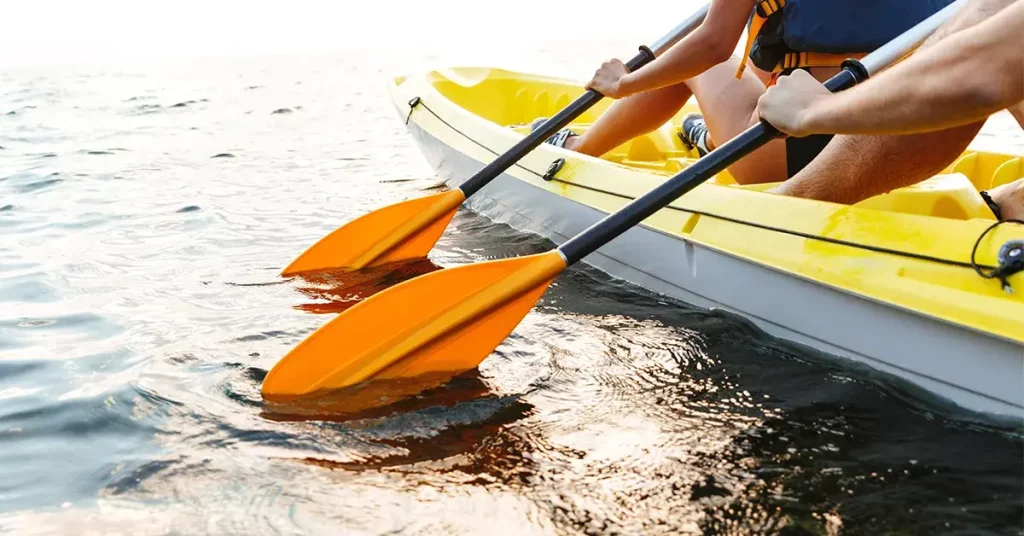Most kayakers wonder how much weight can a kayak hold. The performance weight limit will decide how much gear you can bring and whether the kayak is the right size.
Setting out with a kayak that is not big enough for your equipment is an easy way to have a terrible kayaking adventure.
This article will explore kayak weight limits. This is essential information that people often overlook when they first start kayaking. We’ll also dive into the consequences of exceeding the kayak weight limit and what you should do if this happens. Water safety is essential when spending time out on the water so you should take every precaution to ensure a successful and safe kayaking trip.
What Is a Kayak’s Weight Limit?

Kayak weight limits are in place for safety. When most people purchase or rent a kayak, they are not thinking about the kayak weight capacity. This is a common mistake that leads to a lot of problems. There is also much confusion regarding a kayak’s performance weight limit.
Kayak weight capacity numbers
There are multiple names for a kayak weight limit, including “maximum weight limit”, “maximum capacity”, “load limit”, and “weight rating”. The numbers assigned to these terms equal the highest weight capacity that can be put on the kayak for it to safely stay afloat.
A kayak’s practical weight limit is posted to help people choose the right kayak for their purposes. Unfortunately, it ends up causing more confusion than help.
No universal capacity standards
There are no universal industry standards for evaluating a kayak’s maximum weight capacity. Each company makes specific weight ratings for their products, so it is hard to compare kayaks across brands.
Don’t include yourself
Additionally, many people confuse a kayak weight limit for the maximum weight of the paddler. The weight limit is the maximum weight that the kayak can safely carry, including the kayaker’s weight, gear, and any other items in the kayak.
Therefore a kayak with a 200-pound maximum weight capacity is not suitable for a 200-pound individual. Furthermore, if you load a kayak to its weight limit, it will not be usable. The kayak will be low in the water and difficult to maneuver.
It is best practice to give yourself at least 25 pounds of wiggle room under the weight limit. Any kayak you plan to use should have a weight limit of at least 25 pounds more than your body weight and gear combined.
What Happens if you Surpass the Maximum Weight Capacity on a Kayak?

If you exceed the maximum weight capacity of your kayak, the consequences can be dire. You risk sinking your kayak, which can lead to dangerous situations.
Additionally, if you are paddling in a group, exceeding the weight capacity on your kayak can put other people at risk. If your kayak sinks, it will take any other kayaks attached to it down.
It is essential to be aware of your kayak’s weight limit and ensure you do not exceed it. If your kayak is overloaded, there are some things you can do to try and rectify the situation.
What to do if your kayak is too heavy
The first thing you should do is remove any unnecessary weight from the kayak. This may mean taking out gear or dumping out the water you are carrying.
You should try to lighten your load by getting out of the kayak and onto the shore. Once you have removed as much weight as possible, you can try to re-enter the kayak and paddle to shore.
If you cannot remove enough weight from the kayak or it is taking on too much water, you may need to abandon the ship. This means getting out of the kayak and swimming to shore.
It is essential to be aware of your kayak’s weight capacity and ensure you do not exceed it. Exceeding the weight limit on a kayak can lead to dangerous situations for you and anyone else paddling with you.
What is the Weight Capacity of the Average Kayak?

The average kayak can hold between 250 and 300 pounds. The weight limit will change depending on the type of kayak, but most recreational kayaks fall within this range.
Fishing kayaks
Fishing and camping kayaks have a higher weight limit. These types of kayaks usually have a weight limit of around 350.
Sit-on-top kayaks
Sit-on-top kayaks are somewhat larger than fishing or camping kayaks. This type of kayak is wide and stable and is more similar to a canoe than a kayak. They have a weight capacity of 350 to 400 pounds.
Tandem kayaks
Tandem kayaks are the largest of the bunch. Tandem kayaks are designed to support two people and double the equipment, food, etc. In addition to being longer and wider than traditional kayaks, tandem kayaks have an average maximum weight limit of around 500 to 600 pounds.
Wrap Up
As you can see, knowing just how much weight can a kayak hold is a bit complicated. It is an essential piece of information for any kayaker to know, but there is a lot of confusion surrounding it.
A kayak’s weight capacity refers to the maximum weight that a kayak can support. This includes the paddler and any gear being carried. Additionally, it is wise to be under the weight limit to ensure optimal performance in the water.
If you are over the weight limit of your kayak, you are in a potentially dangerous situation. Your kayak can sink and take all of your gear and you with it. If your kayak is over the weight limit, the best action is to beach your kayak and get rid of unnecessary equipment.
Because the average weight limit of a kayak depends on the type of kayak and its design, be mindful of the max capacity and what you may bring along on your excursions before making a purchase.
See you on the water!




